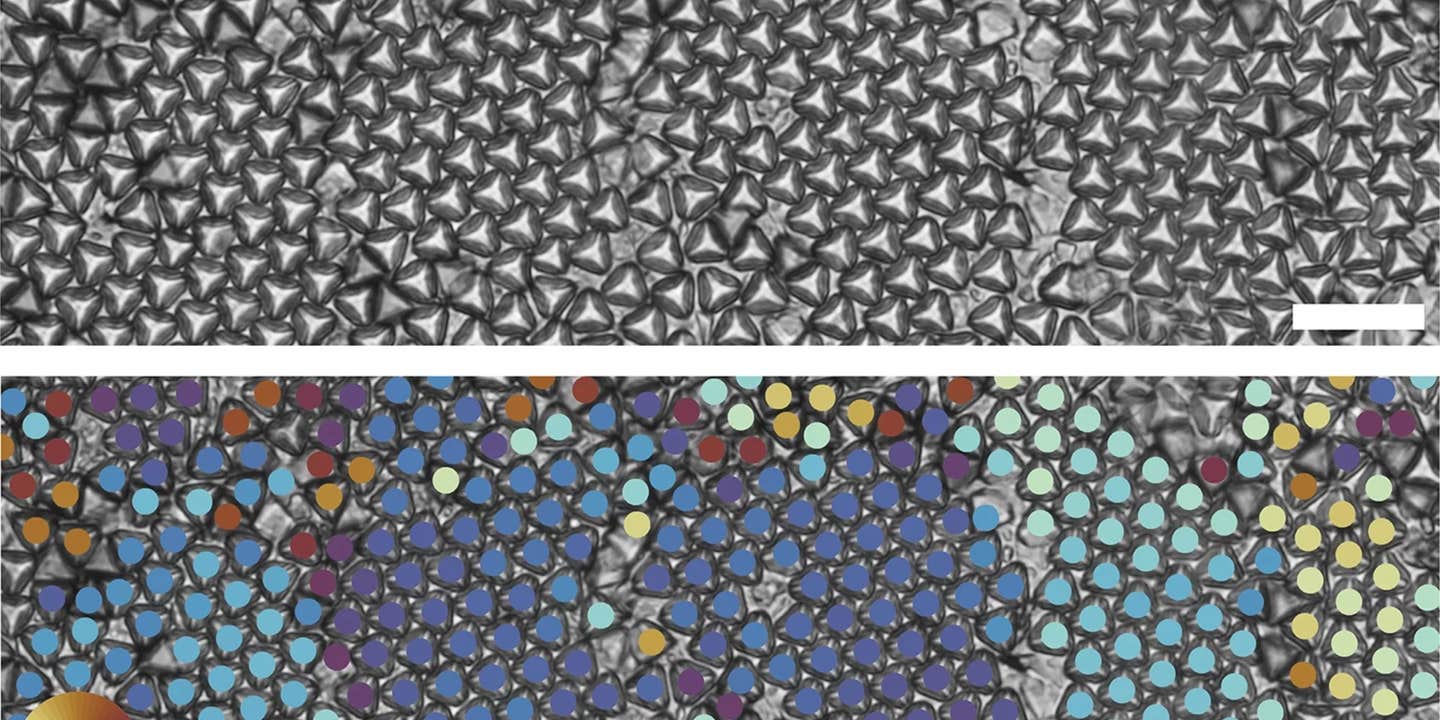3D printed nanoparticles could create novel shapeshifting materials
In the science of nanomaterials, shape holds paramount importance. It determines the physical attributes of the resulting material.

Optical images of truncated tetrahedrons forming multiple hexagonal grains (top). Bond order analysis shows different hexagonal grains through different colors (bottom). Neighboring tetrahedrons that have the same color indicate that they have the same grain orientation. Scale bar is 20 um. (CREDIT: David Doan & John Kulikowski)
In the science of nanomaterials, shape holds paramount importance. It determines the physical attributes of the resulting material. Wendy Gu, an assistant professor of mechanical engineering at Stanford University, highlighted this concept in her recent study published in Nature Communications.
Gu's team utilized a cutting-edge 3D nanoprinting technique to fabricate Archimedean truncated tetrahedrons (ATTs), micron-scale tetrahedrons with their tips truncated, known for their promising properties.
Gu explained, "A crystal made of nano-ball bearings will arrange themselves differently than a crystal made of nano-dice and these arrangements will produce very different physical properties."
Confocal images of truncated tetrahedrons forming several quasi-diamond grains (left). Bond order analysis shows different quasi-diamond grains through alternating colors (right). Neighboring tetrahedrons that have alternating colors (i.e., blue and red/brown, or dark blue and yellow) indicate that they have the same grain orientation. Scale bars are 20 um. (CREDIT: David Doan & John Kulikowski)
Their research involved nanoprinting tens of thousands of these ATTs, dispersing them into a solution, and observing their self-assembly into various crystal structures.
Crucially, these materials possess the ability to transition between states rapidly by rearranging the particles into new geometric patterns, akin to the atomic rearrangement in transforming iron into tempered steel or in materials facilitating data storage in computers.
"This ability to change 'phases' could lead in many promising engineering directions," Gu remarked, emphasizing the potential of controlling phase shifts in materials comprising ATTs.
Related Stories
While ATTs have been theorized as ideal geometries for phase-changing materials, their fabrication posed significant challenges until now. Gu's team, employing 3D nanoprinting, achieved a breakthrough in producing these nanoparticles in quantity.
"With 3D nanoprinting, we can make almost any shape we want. We can control the particle shape very carefully," Gu elucidated. "This particular shape has been predicted by simulations to form very interesting structures."
ATTs exhibit at least two desirable geometric arrangements: a hexagonal pattern and a crystalline quasi-diamond structure. In the hexagonal pattern, the tetrahedrons lie flat on the substrate with their truncated tips pointing upward, resembling a nanoscale mountain range.
Optical images of truncated tetrahedrons forming two large hexagonal grains at an anti-phase boundary (left), and transforming into a quasi-diamond phase that initiated at the anti-phase boundary (right). Scale bars are 25 um. (CREDIT: David Doan & John Kulikowski)
The quasi-diamond structure, alternately upward- and downward-facing, holds even greater promise, resembling eggs in an egg carton. This diamond arrangement is highly coveted in the photonics field, offering avenues for novel scientific exploration.
Gu envisioned various applications for ATT-based materials, such as solar panel coatings that optimize energy efficiency throughout the day, hydrophobic films for aircraft surfaces preventing fogging or icing, and innovative computer memory solutions.
Geometric models of self-assembled particles within volumetric cells and the resulting single-cell occupancy free energy calculations as a function of packing fraction of the hexagonal state (navy blue) and the quasi-diamond state (pink). (CREDIT: Nature Communications)
"We're working on making these particles magnetic to control how they behave," Gu revealed, hinting at ongoing research endeavors exploring novel applications of ATT nanoparticles. "The possibilities are only beginning to be explored."
Additional co-authors of the work are PhD students David Doan and John Kulikowski. Gu is also a member of Stanford Bio-X.
For more science news stories check out our New Discoveries section at The Brighter Side of News.
Note: Materials provided above by The Brighter Side of News. Content may be edited for style and length.
Like these kind of feel good stories? Get the Brighter Side of News' newsletter.



